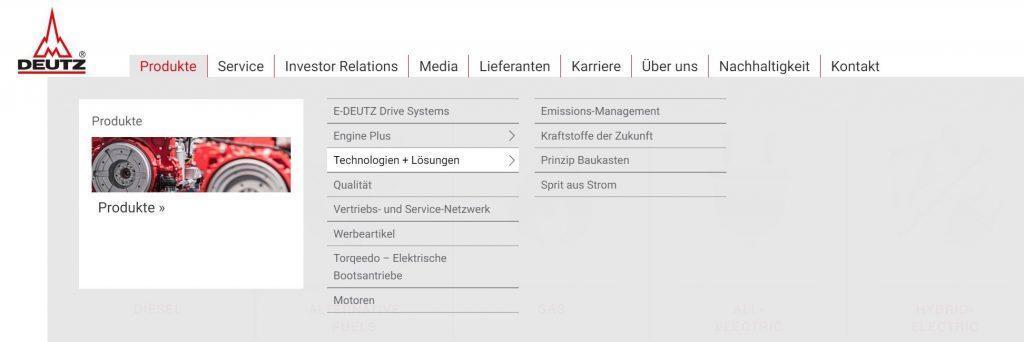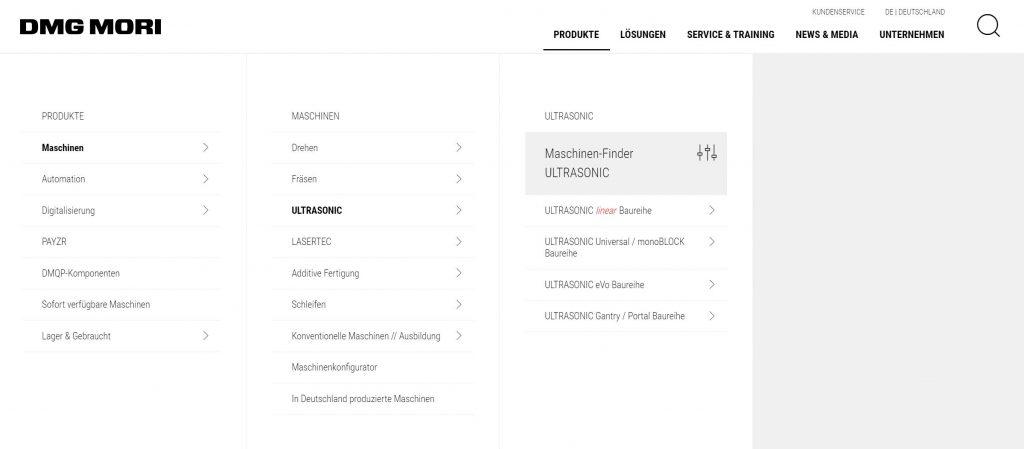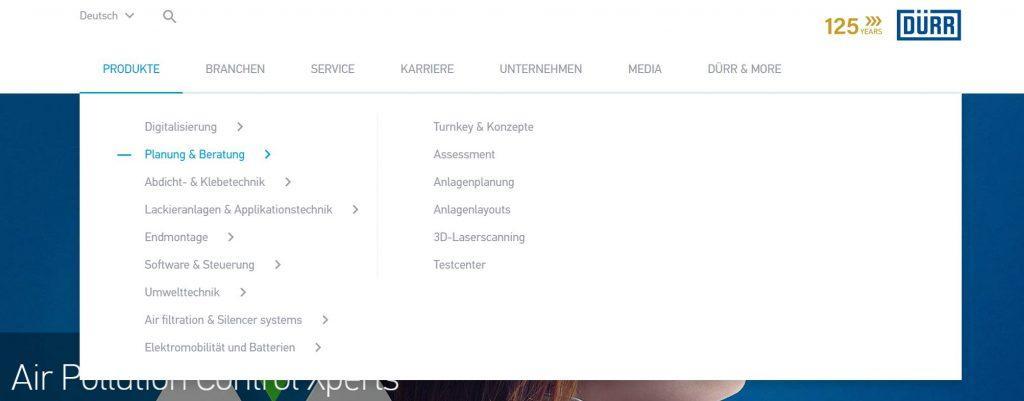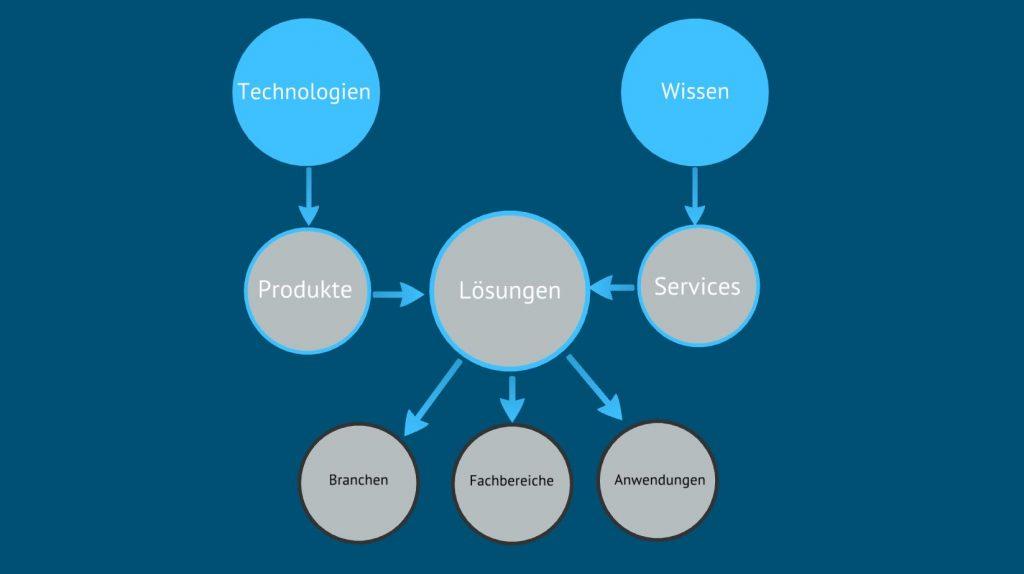B2B Content Marketing – die wichtigsten Tipps & Beispiele
In den letzten gut 20 Jahren haben wir unzählige Webauftritte von B2B Unternehmen begleitet. Content Marketing war hier häufig ein Fremdwort. Selbst das Marketing in großen Unternehmen mit über 1.000 Mitarbeitern war oft eher schwach ausgeprägt. Es macht daher Sinn mit den Basics anzufangen: Website-Struktur und die grundlegende Ansprache.
Die B2B Website-Struktur optimieren
Man mag es nicht glauben, aber es ist wahr: Viele B2B Unternehmen glauben immer noch, dass die Kunden beim richtigen Produkt quasi von alleine kommen. Es hat ja immer noch funktioniert. Letztlich ist das auch in Ordnung, wenn es so läuft. Wir haben viele Weltmarktführer in Nischen im Bereich Maschinenbau, Elektrotechnik, Medizintechnik, Anlagenbau und ähnliches betreut. Wer das allerbeste Produkt hat, bei dem reicht anscheinend der jährliche Auftritt auf der größten Branchenmesse. Doch wenn das nicht der Fall ist, so bedarf es einer ausgefeilten Content Strategie.
Apropos Messe: Das war mit Corona jetzt erstmal vorbei. Da sieht man, wie schnell etablierte Kontaktanbahnungen verschwinden können. Und plötzlich musste jeder sehen, wie er zu neuen Kunden kommt. Damit war der Webauftritt von einem Moment zum nächsten wieder strategisch wichtig.
Es sind aber nicht nur solche Ereignisse. Auch die Globalisierung mit immer mehr Konkurrenz aus dem Ausland, nicht nur China, und die fortschreitende Digitalisierung machen es auch für die allerbesten Unternehmen ihrer Branche notwendig, sich Gedanken über die Ansprache von Neukunden zu machen.
Das Ziel einer jeden Website-Struktur sollte es sein, möglichst klar den User zu den Inhalten zu führen. Produkte sind Produkte. Sie basieren auf bestimmten Technologien. (Dienst-)leistungen sind Leistungen oder auch Services. Sie basieren auf Wissen. Beides kombiniert sind Lösungen. Diese werden eingesetzt in bestimmten Branchen, für bestimmte Anwendungen oder Fachbereiche. Und da beginnt das große Durcheinander.
Man sollte meinen, dass der Bereich der Produkte und Dienstleistungen derjenige ist, in dem am meisten Klarheit herrscht. Das typische B2B Unternehmen dreht sich nun mal primär um sich selbst und seine tollen Erfindungen. (Randbemerkung: Ich liebe es mit Ingenieuren zu sprechen, Werksführungen zu machen und zu verstehen, was mit Leidenschaft und Liebe zum Detail alles möglich ist.). Und auch wie und wo die Produkte eingesetzt werden, sollte eigentlich klar sein. Erstaunlicherweise haben wir immer wieder ein gehöriges Durcheinander in genau diesem entscheidenden Bereich vorgefunden.
B2B Content Marketing Beispiele von aktuellen Websites führender deutscher B2B-Unternehmen

Ich frage mich: Was hat die Qualitätsgarantie hier verloren?

Die Struktur ist wirklich gruselig. Hat Bayer wirklich keine wichtigeren Produkte als Patienteninformationen, Infos zu Arzneimittelfälschungen, Infos zu Fälschungen in der Landwirtschaft und Nebenwirkungen???

Noch ein Grauen. Neun Hauptnavigationspunkte sind schon mal ein Unding. Die Grundregel ist maximal 7. Mehr kann auf einmal nicht wahrgenommen werden. Alles weitere gehört in die 7 Hauptpunkte einsortiert, z.B. Karriere unter Über uns oder Lieferanten in eine separate kleine Nebennavigation. Technologien sind wichtig und es ist toll etwas darüber zu sagen. Aber in Kombination mit Lösungen?

Die Navigation ist auf den ersten Blick sehr schön. Nur 5 Hauptpunkte: Super. Drehen und Fräsen wären aber besser unter Anwendungen einsortiert.

Und noch ein Beispiel, wo mit den Hauptpunkten Produkte, Branchen und Service ein guter Ansatz verfolgt wurde. Planung & Beratung sind aber eindeutig Services bzw. Leistungen und keine Produkte.
Die Reihe ließe sich unendlich fortsetzen.
Ich empfehle folgende einfache Struktur zu verwenden:

Hier sortierst du alles ein, was es in eurem Unternehmen gibt.
Und dann entscheidest du, wo du auf der Website Schwerpunkte setzen möchten. Jeder dieser Punkte kann ein Hauptnavigationspunkt sein. Du kannst auch Produkte & Services kombinieren, nur bitte nicht Produkte schreiben und Services darunter auflisten. Klingt banal, macht die Nutzung deiner Website für deine Kunden aber einfacher.
Technologien und Wissen können beispielsweise auch über Stories transportiert werden. Wenn eine bestimmte Technologie aber die Basis eures gesamten Unternehmens ist, solltest du einen Hauptnavigationspunkt daraus machen. Die richtigen Prioritäten zu setzen, ist das A und O der Website-Struktur.
Die grundlegende Ansprache im B2B Content Marketing
Aus der Ich-Zentrierung vieler B2B Unternehmen folgt zwangsläufig ein zweites Thema der textlichen Ansprache. Es geht in den Texten viel zu häufig um die Features der Produkte und viel zu wenig um den Nutzen, den die Kunden davon haben.
Aus den Features der Produkte entsteht ein Mehrwert für den Kunden. Dieser Wert hat für den Kunden eine Bedeutung. Auf Neudeutsch: Features > Benefit > Meaning.
So sind die meisten B2B Websites aufgebaut.
Seht her: Das sind die neuesten Features unserer tollen Produkte. Viele große Bilder. Viel Text. Vielleicht sogar ein Video. …
Du kannst damit Dies und Das machen. Viel weniger Text. Vielleicht ein Bild. Kein Video.
Das bedeutet für dich … kommt meistens gar nicht mehr vor.
Drehen Sie doch einfach mal die Richtung um:

Überlege, welche Bedeutung dein Produkt für deine Kunden hat. Die neuen Features lassen ihn seine Arbeit schneller machen, wodurch er mehr Zeit für andere wichtige Dinge gewinnt.
Dann zeige doch ruhig mal deinen Kunden in einem Video dabei, wie er die anderen Dinge endlich erledigen kann. Mit Video.
Und dann in ein paar Sätzen, dass das nun geht, weil er jetzt endlich Zeit dafür hat.
Dank deiner neuen Features, die du ihm gerne persönlich erklärst. Hier geht es zum Kontakt …
Merkst du etwas?
In den meisten B2B Unternehmen stellt das die bisherige Denkweise auf den Kopf. Macht aber nichts. Deine Kunden werden es dir danken. Und dein Chef auch – spätestens, wenn die Verkaufszahlen hoch gehen.
Zusammenfassung
Der Kunde steht im Mittelpunkt, nicht das Unternehmen und seine Produkte. Zeige ihm schon in der Struktur, dass du es ihm einfach machst, deine Produktwelt zu verstehen. Und spreche ihn so an, dass er mit seinen Bedürfnissen abgeholt wird. So wird dein B2B Content Marketing zum Erfolg.



